Histamine intolerance

Often after the New Year's feast, we notice a rash on the skin, redness and feel itchy. Allergy? Maybe. But there is another factor that is much more common than food allergies and manifests itself in culinary excesses. This is a histamine food intolerance.
Histamine is a natural mediator that is constantly present in the body, and also enters the intestines along with food.
Histamine is produced during allergic reactions, acting on specific receptors and causes the corresponding clinical manifestations, such as itching, urticaria, runny nose and bronchospasm.
Food intolerance to histamine (HIT - Histamine Intolerance) occurs when there is an excess or insufficient utilization of histamine by the body. Excessive levels of histamine affect all organs and systems of the body, causing various specific symptoms reminiscent of food allergies - rash, itching, hives, runny nose, bronchospasm, as well as various intestinal disorders, migraines, and others.
Foods rich in histamine:
In our Medical Center you can get tested for food intolerance to histamine. Diagnostics is carried out in two ways - by skin (prick test) and by blood.
After the diagnosis, we will advise you on further treatment.
Histamine is a natural mediator that is constantly present in the body, and also enters the intestines along with food.
Histamine is produced during allergic reactions, acting on specific receptors and causes the corresponding clinical manifestations, such as itching, urticaria, runny nose and bronchospasm.
Food intolerance to histamine (HIT - Histamine Intolerance) occurs when there is an excess or insufficient utilization of histamine by the body. Excessive levels of histamine affect all organs and systems of the body, causing various specific symptoms reminiscent of food allergies - rash, itching, hives, runny nose, bronchospasm, as well as various intestinal disorders, migraines, and others.
Foods rich in histamine:
- alcohol;
- various canned, pickled, as well as fermented foods;
- smoked meats, including sausages, ham and more;
- legumes, including soy, chickpeas and lentils;
- aged cheeses;
- vinegar;
- yogurts;
- salty snacks;
- sweets that contain preservatives;
- cocoa and, as a result, chocolate;
- most citrus fruits, as well as pineapples, bananas, strawberries, cherries;
- green tea;
- tomatoes, eggplant, spinach;
- canned fish (tuna, mackerel);
- some spices (cloves, cinnamon, chili);
- peanut.
In our Medical Center you can get tested for food intolerance to histamine. Diagnostics is carried out in two ways - by skin (prick test) and by blood.
After the diagnosis, we will advise you on further treatment.
Waiting for you!



